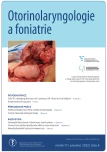Oropharyngeal tularemia with skin manifestation: Sweet’s syndrome
Authors:
B. Stárková; Richard Salzman
Authors‘ workplace:
Klinika otorinolaryngologie a chirurgie hlavy a krku LF UP a FN Olomouc
Published in:
Otorinolaryngol Foniatr, 71, 2022, No. 4, pp. 225-229.
Category:
Case Reports
doi:
https://doi.org/10.48095/ccorl2022225
Overview
The authors present a case report of a patient with unilateral tonsillitis and severe non-specific inflammatory response not responding to anti-biotic therapy. Along with persistent local and systemic symptoms, the patient also developed skin exanthema and cervical lymphadenopathy. The definitive diagnosis of oropharyngeal tularemia was confirmed after several weeks, based on serological and histological findings. Finally, the targeted antibiotic therapy led to rapid symptom resolution. The authors describe an unusual combination of the diagnoses, which resulted in a prolonged and initially unsuccessful therapy. Symptoms resembling to tonsillitis, which persist despite the use of antibiotics, should lead to reconsideration of suspected diagnosis.
Keywords:
tularemia – lymphadenopathy – tonsillitis – Sweet’s syndrome
Sources
1. Prokšová M, Bavlovič J, Klimentová J et al. Tularémie – zoonóza s rizikem bioterorismu. Epidemiol Mikrobiol Imunol 2018; 68 (2): 82–89.
2. Sweet RB. An acute febrile neutrophilic dermatosis. Br J Dermatol 1964; 76 (8–9): 349–356. Doi: 10.1111/j.1365-2133.1964.tb14541.x.
3. Boudyšová M, Ettler K, Podhola M et al. Akutní febrilní neutrofilní dermatóza – Sweetův syndrom. Čas Lék čes 2012; 151 (7): 359–361.
4. Rochet NM, Chavan RN, Cappel MA et al. Sweet syndrome: Clinical presentation, associations, and response to treatment in 77 patients. J Am Acad Dermatol 2013; 69 (4): 557–564. Doi: 10.1016/j.jaad.2013.06.0023.
5. Heath MS, Ortega-Loayza AG. Insights Into the Pathogenesis of Sweet‘s Syndrome. Front Immunol 2019; 10: 414. Doi: 10.3389/ fimmu.2019.00414.
6. Ruiz AIB, González A, Miranda A et al. Sweet‘s syndrome associated with francisella tularensis infection. Int J Dermatol 2002; 40 (12): 791–792. Doi: 10.1046/j.1365-4362.2001.01162.x.
7. Mualla P, Haydar PA, İsmail Ö et al. Erythema nodosum and Sweet’s syndrome in patients with glandular tularemia. Int J Dermatol 2011; 50 (7): 866–869. Doi: 10.1111/j.1365-46 32.2010.04647.x.
8. Polat M, Karapınar T, Sırmatel F. Dermatological aspects of tularaemia: a study of 168 cases. Clin Exp Dermatol 2018; 43 (7): 770–774. Doi: 10.1111/ced.13548.
9. SZÚ. Infekce v ČR – ISIN. 2022 [online]. Dostupné z: http: //www.szu.cz/publikace/data/ infekce-v-cr.
10. Špačková M, Orlíková H, Fabiánová K et al. 29. Pečenkovy epidemiologické dny v Plzni, 2020. Epidemiol Mikrobiol Imunol 2020; 69 (4): 195–197.
11. Karakas A, Coskun O, Artuk C et al. Oropharyngeal tularemia cases admitted to a military hospital in Ankara, Turkey. J Infect Dev Ctries 2014; 8 (8): 994–999. Doi: 10.3855/jidc. 4332.
12. Celebi G, Baruönü F, Ayoğlu F et al. Tularemia, a reemerging disease in northwest Turkey: epidemiological investigation and evaluation of treatment responses. Jpn J Infect Dis 2006; 59 (4): 229–234.
13. Zavázalová Š, Jirák P, Syrůček M et al. Castlemanova choroba – Mimicking a malignant lymphoma. Otorinolaryngol Foniatr 2014; 63 (4): 246–250.
14. Chovanec M, Komínek P, Zeleník K. Příručka pro praxi: Diferenciální diagnostika krčního uzlinového syndromu. Praha: Česká společnost otorinolaryngologie a chirurgie hlavy a krku, 2014.
15. Markoc F, Koseoglu RD, Koc S et al. Tularemia in Differential Diagnosis of Cervical Lymphadenopathy: Cytologic Features of Tularemia Lymphadenitis. Acta Cytol 2014; 58 (1): 23–28. Doi: 10.1159/000355869.
16. Windfuhr JP, Toepfner N, Steffen G et al. Clinical practice guideline: tonsillitis I. Diagnostics and nonsurgical management. Eur Arch Otorhinolaryngol 2016; 273 (4): 973–987. Doi: 10.1007/s00405-015-3872-6.
17. McEwan J, Basha S, Rogers S et al. An unusual presentation of cat-scratch disease. J Laryngol Otol 2001; 115 (10): 826–828. Doi: 10.1258/0022215011909071.
18. Arikan OK, Koc C, Bozdogan O. Tularemia presenting as tonsillopharyngitis and cervical lymphadenitis: a case report and review of the literature. Eur Arch Otorhinolaryngol 2003; 260 (6): 298–300. Doi: 10.1007/s00405-002-05 65-8.
19. Dlugaiczyk J, Harrer T, Zwerina J et al. Oropharyngeal tularemia – a differential diagnosis of tonsillopharyngitis and cervical lymphadenitis. Wien Klin Wochenschr 2010; 122: 110–114. Doi: 10.1007/s00508-009-1274-8.
Labels
Audiology Paediatric ENT ENT (Otorhinolaryngology)Article was published in
Otorhinolaryngology and Phoniatrics

2022 Issue 4
Most read in this issue
- Chronic rhinosinusitis of dental origin
- Compartmental tongue surgery
- Congenital cytomegalovirus infection from the viewpoint of otorhinolaryngologist
- The role of FEES and the dysphagia team in the management of patients after stroke disease in Hospital České Budějovice
